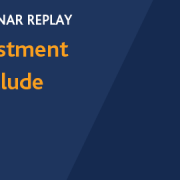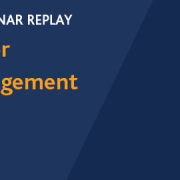Give Clients Guaranteed Income in a Post-DOL World
The future keeps a lot of people awake at night: 56% of Americans lose sleep thinking about retirement.
– Ramsey Solutions, Stress and Anxiety Surrounding Retirement An In-Depth Look at What Keeps Americans Up at Night, Aug 10, 2016
The search for solutions that fit into the fixed income bucket or address longevity risks, the list gets pretty short. Scott Martin from The Trust Advisor does a nice job of reporting on recent changes that make annuities an attractive option for investment advisors.
Give Clients Guaranteed Income in a Post-DOL World
By Scott Martin
February 3, 2017
For a shocking number of retail investors, the ability to lock in basic cash flow expectations outweighs the imperative to chase additional upside.
Planning gurus reveal how advisors with the right processes can deliver 100% confidence and still keep the compliance department happy.
The stock market is one of the best wealth creation engines in human history, but the long-term returns naturally carry a relatively high level of year-to-year risk. Even people who understand the statistics feel the instinctive nervous response when the numbers they rely on to pay the bills lurch in the wrong direction.
While that lurch is a fact of life for every investor, it’s still an emotional drain, especially as the household makes the transition from accumulation to drawing down the assets for current income.
And while guarantees aren’t anything compliance-hardened advisors are trained to embrace, sometimes it’s all that stands between clients retreating to the sidelines to avoid wasting real purchasing power in zero-yield money markets and bank products.
The people with the Modernist Advisor have found a way to provide that guarantee in a compliant environment. The ideas are a little outside the style box but the implementation promises to be extremely interesting, maybe even transformative.
Paying to eliminate risk
The Modernist Advisor is a marketing program that’s exclusively for RIAs, IARs and hybrid reps. They are showing RIAs how to work with income annuities, which are only now finding a home in equity-heavy RIA platforms. As you know, the core proposition here is that some investors will pay a premium — giving up potential upside, sacrificing a bit of principal and surrendering survivor benefits — in order to count on a certain level of regular income.
That guarantee liberates at least that part of the portfolio from market risk. As long as nothing happens to the carrier, the contract keeps paying, through bear and bull seasons alike.
For clients who are willing to pay that price in order to know the bills will be paid, this is the best outcome. It achieves their stated financial goals. Francois Gadenne, Executive Director of the Retirement Income Industry Association is a fan of annuities, where they fit. He’s a bigger fan of the fiduciary-based income planning process offered by his non-profit educational group.
“Using this process for IRA rollovers meets the ERISA Prudence and DOL’s BICE Best Interest standards,” according to Marcia Wagner Esq. of the Wagner Law Firm.
“We believe that RIAs can overcome the challenge of decumulation, help clients achieve better outcomes and build stronger businesses through the use of annuities and fiduciary-based retirement planning, “ said Jack Martin, CFP of the Modernist Advisor.
How much market risk does a particular annuity eliminate? How does that improve the probability that a particular client will live comfortably without fear of living too long?
Stop fighting the risk profile
A big part of your job is to smooth the ride and provide comfort. If that isn’t happening, a client will never be happy.
And let’s face it, that’s something the automated investment services haven’t learned to do yet. The robots generate equity-heavy portfolios, mashing clients into cookie-cutter allocations without much thought to individual psychology — or even a way to measure psychic stress.
Flesh-and-blood advisors, on the other hand, already know risk is a sore spot for otherwise wealthy people who’ve lived through deep market corrections and just don’t want to swallow the volatility for the chance to stretch their returns.
Those people aren’t flocking to the robo platforms. They want human advice on their retirement goals, cash flow, philanthropy and estate plans just like any other full-service client.
The pivot here revolves around integrating a new wave of annuity contracts into conventional portfolio reporting and analytics systems.
Of course these aren’t the complicated return-chasing products that imploded in a cloud of bells and whistles and left a generation of already risk-averse accumulation-phase investors in the lurch.
This is fixed-indexed territory: nothing fancy beyond a classic guaranteed income floor, exposure to the market upside and nothing to hide from modern regulators. Safe haven letters are in place. Fiduciaries can use them for the right clients.
You can crunch the numbers yourself and see how they’d fit into your existing client strategies. That’s where Modernist Advisor technology comes in, letting advisors plug the contracts right into the portfolio construction process.
Giving clients what they actually want
For those risk-averse clients, it’s a whole lot more sympathetic than all the statistics that we traditionally throw at people who just don’t trust the stock market.
I’m sure you can recite the arguments in your sleep at this point: equity is volatile but in the long term the trends point up faster than inflation, making exposure ideal for accumulation as well as wealth preservation purposes.
Those arguments become routine because we have to make them over and over, often to a completely unreceptive prospect. To a certain segment of the investing public, equities in all their forms — individual stocks, funds, ETFs, SMAs — are simply a hard sell.
The problem, of course, is that bonds don’t look all that secure right now and even if they are, the income profile will remain pathetic for at least the next few years.
The income floor on modern annuity contracts makes them a viable replacement for at least part of a fixed-income allocation. And the clients who don’t like stocks get the guarantee while you get a place to account for that income on the household financial plan.
Integrating the annuity into the plan
Once annuity income is in play, advanced techniques open up.
You can balance guaranteed income against systematic withdrawals elsewhere in the portfolio to maximize overall income, or even earmark assets with different risk-return profiles for legacy purposes once lifestyle needs are met.
You can work with required distributions from qualified accounts or adjust under unusual market conditions.
Standing behind the Modernist Advisor are the seasoned pros at DBHC. “Our 3 decades of successful experience with advisors makes us a valuable strategic partner for RIAs in the retirement planning business,” commented Mike Dressander, President of DBHC.
When it comes to the fine points of implementation the DBHC team is best positioned to address for those who already buy into the annuity-enhanced approach and build growing business. Personally, I’m at least as interested in what the firm has figured out about those stock-wary investors.
Those of you who’ve fought to keep clients on the optimal allocations know that it’s like pushing water uphill. Sooner or later, the dam you’ve built breaks and the assets flow away again.
If a client gets so scared that you need to argue, run the numbers on guaranteed income instead. Seeing the math will either be reassuring — you can preserve the relationship at a dramatically lower risk level — or prompt the client to ask for more.
Asking for more might involve a layer of equity on top of a guaranteed base. The platform can figure that out.
An advisor could do well to brand himself or herself as a retirement income specialist. After all, there’s a lot of money out there parked in money markets paying practically nothing. You can add value, provided you know who to talk to.
Give Clients Guaranteed Income in a Post-DOL World by Scott Martin was originally posted on thetrustadvisor.com on February 3, 2017.













Leave a Reply
Want to join the discussion?Feel free to contribute!